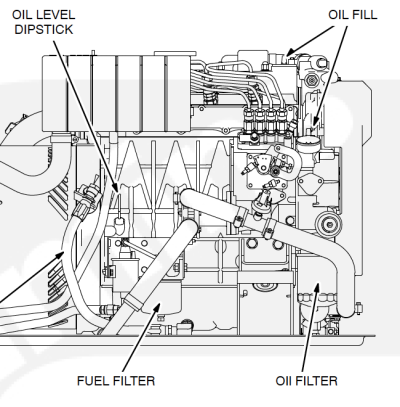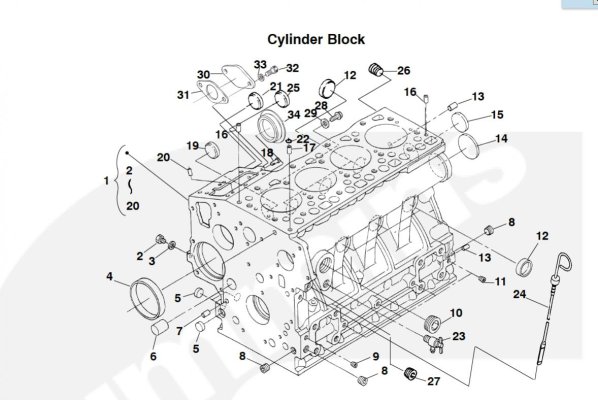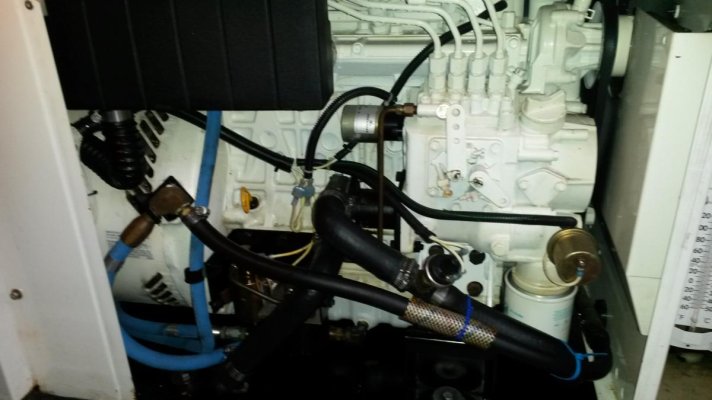I have a long-latency (days) high-flow oil leak on my Onan MDKAW.
Preliminary diagnosis... It leaks all the way down to the bottom of the pan -------> it's the pan
Facts...
○ This began after MONTHS (6... more?) on the hard.
○ I had to get thru some leak-test training from the AF in 1981 but never had to use any of it.
○ The leak demonstrated that when it begins, it is significant... across days. Big mess... PITA cleaning it up.
○ Then I got more serious about diagnosis... I mixed up some UV tracer dye with a quart of oil and poured it in to the fill cap near the non-generator end of the motor.
§ I waited 6 hr... no joy
§ 2 or 3d later, well, the first thing you know old Jed's a millionaire, etc. Catch pan overflowed. Lots of cleanup.
§ But NO obvious leaks glowing anywhere.
○ New experiment... months later..
§ No oil showing on the dipstick
§ Measured how much actual oil was left with a welding rod down the dipstick hole... slightly < 0.25"
§ The pan has only two holes manufactured into it. One in back - plugged, one in front where the Reverso pump connects. No glowing at either, but I need to take a second more caredul look at the one in the back (I'm ancient and used up and am limited how much time I can spend in that position),.
§ I think I should have stopped here..
§ Mixed up another quart of oil/tracer - added it directly to the pan.
§ Days of delay.. nothing
§ Then... it leaked.
§ Nothing glowing found.
§ The ability to see into the space under the oil pan and the built in drip tray is low... mostly the design, partly me. Is there a way to know where the first drops emerge from the pan (assuming it is the pan of course) if it takes a variable number of days for the leak to begin.. but once started, coats the entire drip tray?
○ I have to conclude it's a pan failure.
My questions...
1. Has anyone ever seen a pan in a protected space just fail? I've worked on a large number of engines on tractors, trucks, cars and motorcycles and something just rotting away is 100% unfamiliar.
2. This is an Onan MDKAW... supposedly engine by Kubota. Curious if anyone knows....
i. Is this an aluminum or SS pan?
ii. Is there a known issue with this Onan re: oil pans?
iii. How big a pita is it to pull/swap or repair the pan? The vessel is a Nordic Tug 42.
iv. Is there a reliable repair procedure to the pan? I'm a fairly good machinist... weak welder but know many good ones.
v. Are pans available? I can't find one.
vi. Or.. replace the generator? And repair/sell the Onan.
Any insights into this situation would be appreciated.
Preliminary diagnosis... It leaks all the way down to the bottom of the pan -------> it's the pan
Facts...
○ This began after MONTHS (6... more?) on the hard.
○ I had to get thru some leak-test training from the AF in 1981 but never had to use any of it.
○ The leak demonstrated that when it begins, it is significant... across days. Big mess... PITA cleaning it up.
○ Then I got more serious about diagnosis... I mixed up some UV tracer dye with a quart of oil and poured it in to the fill cap near the non-generator end of the motor.
§ I waited 6 hr... no joy
§ 2 or 3d later, well, the first thing you know old Jed's a millionaire, etc. Catch pan overflowed. Lots of cleanup.
§ But NO obvious leaks glowing anywhere.
○ New experiment... months later..
§ No oil showing on the dipstick
§ Measured how much actual oil was left with a welding rod down the dipstick hole... slightly < 0.25"
§ The pan has only two holes manufactured into it. One in back - plugged, one in front where the Reverso pump connects. No glowing at either, but I need to take a second more caredul look at the one in the back (I'm ancient and used up and am limited how much time I can spend in that position),.
§ I think I should have stopped here..
§ Mixed up another quart of oil/tracer - added it directly to the pan.
§ Days of delay.. nothing
§ Then... it leaked.
§ Nothing glowing found.
§ The ability to see into the space under the oil pan and the built in drip tray is low... mostly the design, partly me. Is there a way to know where the first drops emerge from the pan (assuming it is the pan of course) if it takes a variable number of days for the leak to begin.. but once started, coats the entire drip tray?
○ I have to conclude it's a pan failure.
My questions...
1. Has anyone ever seen a pan in a protected space just fail? I've worked on a large number of engines on tractors, trucks, cars and motorcycles and something just rotting away is 100% unfamiliar.
2. This is an Onan MDKAW... supposedly engine by Kubota. Curious if anyone knows....
i. Is this an aluminum or SS pan?
ii. Is there a known issue with this Onan re: oil pans?
iii. How big a pita is it to pull/swap or repair the pan? The vessel is a Nordic Tug 42.
iv. Is there a reliable repair procedure to the pan? I'm a fairly good machinist... weak welder but know many good ones.
v. Are pans available? I can't find one.
vi. Or.. replace the generator? And repair/sell the Onan.
Any insights into this situation would be appreciated.



